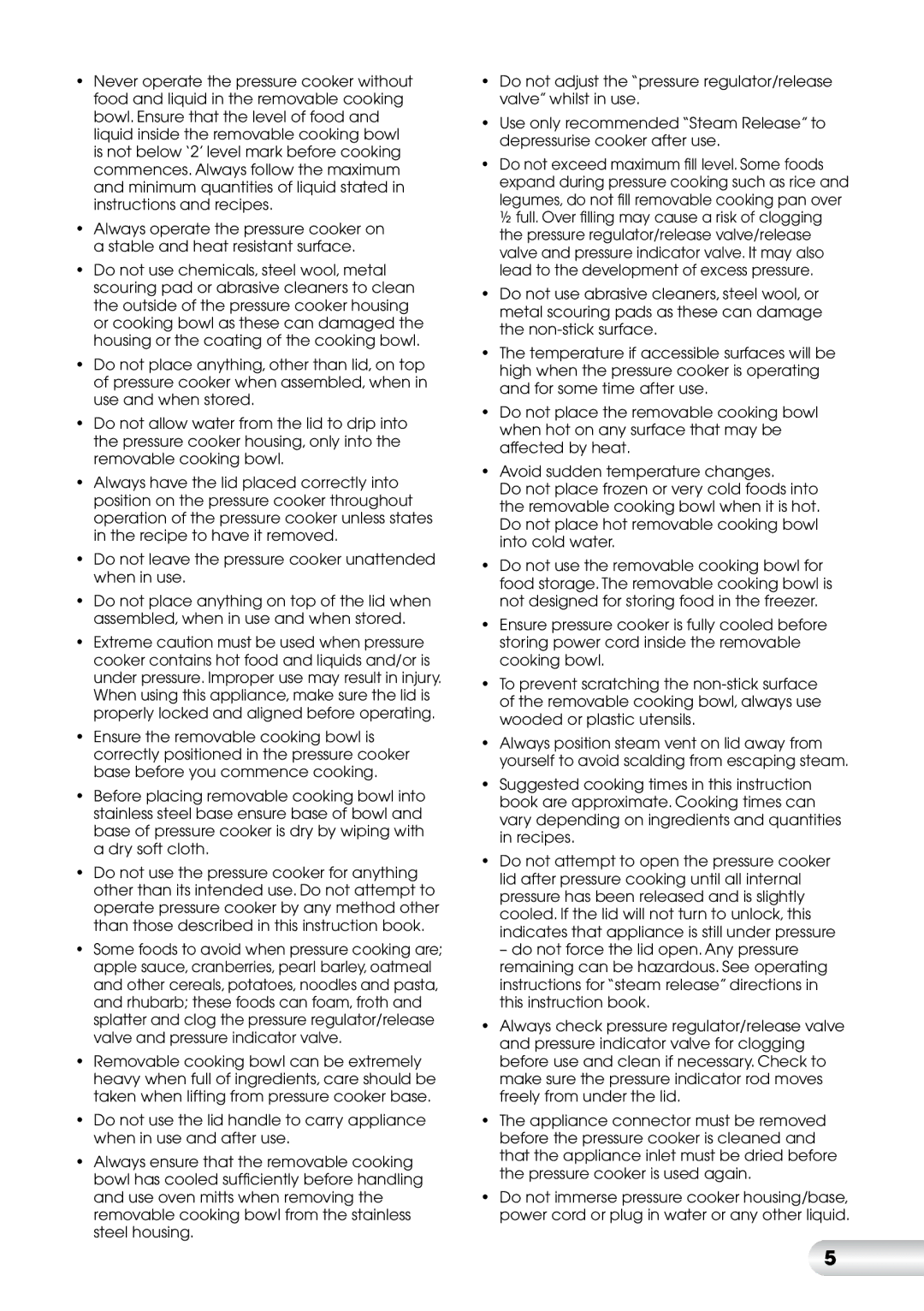•Never operate the pressure cooker without food and liquid in the removable cooking bowl. Ensure that the level of food and liquid inside the removable cooking bowl is not below ‘2’ level mark before cooking commences. Always follow the maximum and minimum quantities of liquid stated in instructions and recipes.
•Always operate the pressure cooker on a stable and heat resistant surface.
•Do not use chemicals, steel wool, metal scouring pad or abrasive cleaners to clean the outside of the pressure cooker housing or cooking bowl as these can damaged the housing or the coating of the cooking bowl.
•Do not place anything, other than lid, on top of pressure cooker when assembled, when in use and when stored.
•Do not allow water from the lid to drip into the pressure cooker housing, only into the removable cooking bowl.
•Always have the lid placed correctly into position on the pressure cooker throughout operation of the pressure cooker unless states in the recipe to have it removed.
•Do not leave the pressure cooker unattended when in use.
•Do not place anything on top of the lid when assembled, when in use and when stored.
•Extreme caution must be used when pressure cooker contains hot food and liquids and/or is under pressure. Improper use may result in injury. When using this appliance, make sure the lid is properly locked and aligned before operating.
•Ensure the removable cooking bowl is correctly positioned in the pressure cooker base before you commence cooking.
•Before placing removable cooking bowl into stainless steel base ensure base of bowl and base of pressure cooker is dry by wiping with a dry soft cloth.
•Do not use the pressure cooker for anything other than its intended use. Do not attempt to operate pressure cooker by any method other than those described in this instruction book.
•Some foods to avoid when pressure cooking are; apple sauce, cranberries, pearl barley, oatmeal and other cereals, potatoes, noodles and pasta, and rhubarb; these foods can foam, froth and splatter and clog the pressure regulator/release valve and pressure indicator valve.
•Removable cooking bowl can be extremely heavy when full of ingredients, care should be taken when lifting from pressure cooker base.
•Do not use the lid handle to carry appliance when in use and after use.
•Always ensure that the removable cooking bowl has cooled sufficiently before handling and use oven mitts when removing the removable cooking bowl from the stainless steel housing.
•Do not adjust the “pressure regulator/release valve” whilst in use.
•Use only recommended “Steam Release” to depressurise cooker after use.
•Do not exceed maximum fill level. Some foods expand during pressure cooking such as rice and legumes, do not fill removable cooking pan over ½ full. Over filling may cause a risk of clogging the pressure regulator/release valve/release valve and pressure indicator valve. It may also lead to the development of excess pressure.
•Do not use abrasive cleaners, steel wool, or metal scouring pads as these can damage the non-stick surface.
•The temperature if accessible surfaces will be high when the pressure cooker is operating and for some time after use.
•Do not place the removable cooking bowl when hot on any surface that may be affected by heat.
•Avoid sudden temperature changes.
Do not place frozen or very cold foods into the removable cooking bowl when it is hot. Do not place hot removable cooking bowl into cold water.
•Do not use the removable cooking bowl for food storage. The removable cooking bowl is not designed for storing food in the freezer.
•Ensure pressure cooker is fully cooled before storing power cord inside the removable cooking bowl.
•To prevent scratching the non-stick surface of the removable cooking bowl, always use wooded or plastic utensils.
•Always position steam vent on lid away from yourself to avoid scalding from escaping steam.
•Suggested cooking times in this instruction book are approximate. Cooking times can vary depending on ingredients and quantities in recipes.
•Do not attempt to open the pressure cooker lid after pressure cooking until all internal pressure has been released and is slightly cooled. If the lid will not turn to unlock, this indicates that appliance is still under pressure
– do not force the lid open. Any pressure remaining can be hazardous. See operating instructions for “steam release” directions in this instruction book.
•Always check pressure regulator/release valve and pressure indicator valve for clogging before use and clean if necessary. Check to make sure the pressure indicator rod moves freely from under the lid.
•The appliance connector must be removed before the pressure cooker is cleaned and that the appliance inlet must be dried before the pressure cooker is used again.
•Do not immerse pressure cooker housing/base, power cord or plug in water or any other liquid.
